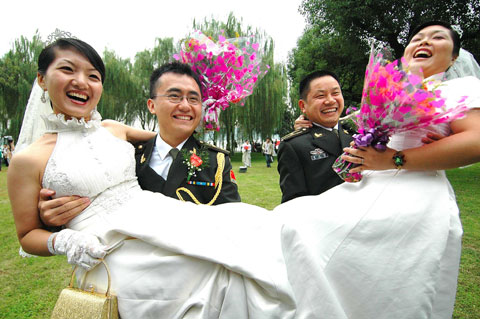It is far from easy for a country of 1.3 billion population to achieve peaceful rise. During the first half of the 21st century, in particular, China faces a period of both "golden opportunity for development" and "standing out contradictions". The latter, in the field of economic and social progress, can be boiled down to "three major challenges".
The first challenge comes from resources, particularly energies. China lags behind the world in terms of per capita hold of resources; meanwhile, due to a fast developing speed yet low technical level, China's manufacturing industry is among the most energy-consuming ones in the world. The huge consumption is intensified by a large-scale shift of manufacturing bases to China. As a result resources, including energies, have been in tight supply.
The second challenge is from ecological environment. A spoiled environment caused by serious pollution, worsened ecological conditions, huge consumption of resources, and low reclamation has become a bottleneck in the sustainable development of the Chinese economy.
The third challenge is posed by a string of "balances" in economic and social development. For example, we have to balance rapid, continuous GDP growth against social construction; to balance the strong momentum in eastern regions against development of central and western areas; to balance equality and gaps to be narrowed down against vigor and efficiency; to balance the deepening of various reforms against social stability... to deal with these dilemmas we need a set of combined measures to realize fast and high-quality development.
Facing the "three major challenges", China's answers can also be summed up in "three major strategies".
The first is to shake off the old industrialization pattern and go on with a new industrial road. It would be a dead end for China to follow the old pattern of high input, high consumption and high pollution. So, the country is determined to open a new path featuring high technological content, high economic returns, low resource consumption, low environmental pollution and full use of its labor advantage.
The second is to leave aside the traditional development pattern of big powers that only rose in modern times as well as the Cold War mentality that drew an ideological line between oneself and his enemies, but continuously take an active part in economic globalization. China refrains from taking the approach of Germany during the WWI and that of Germany and Japan during the WWII who looted resources by force in pursuit of global dominance; nor will it take the road of cold confrontation and power struggle after the WWII. In this way China leapfrogs the old industrialization process that inevitably leads to the rat race for resources, as well as the Cold War mindset that puts ideological differences above peace and development. China will never seek and struggle for hegemony; nor will it take the lead or depends on other countries. We are bravely on our way of reform and opening up, that is, in a course related with economic globalization, we will independently build socialism and head for a rise through learning and introducing various achievements of human civilization.
The third strategy is to transcend obsolete social management pattern and continue to build a socialist harmonious society. Facing new problems cropping up during the reform and opening up that vitality coexists with disorder and efficiency runs alongside imbalance, the Chinese government, in an effort to improve governance capability and social management, is committed to constructing a social network in which governmental and non-governmental forces interconnect with, interact with and complement each other in regulating, governing and managing the society.
The three major strategies, in a word, indicate adherence to peace and harmony, peace with the outside world and harmony at home, with the two factors helping each other. The key is to lead China's 1.3 billion people to brace up for challenges and strike win-win deals with the rest of the world for a better life and bigger contribution to the mankind. That is my understanding of China's development road of peaceful rise.
This article by Zheng Bijian is carried on the first page of the Overseas Edition of People's Daily, June 22.











